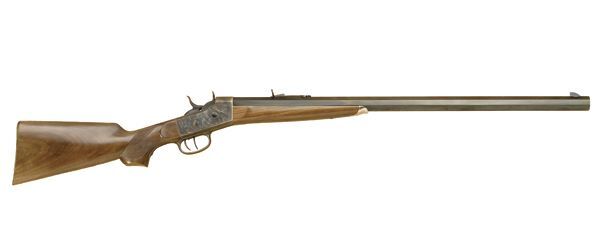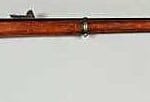
The history of the Adobe Walls rolling block rifles is a fascinating journey through the annals of American firearms development, illustrating the ingenuity and craftsmanship that characterized the late 19th century. These rifles are closely associated with a specific historic event—the Second Battle of Adobe Walls in 1874—but their story extends far beyond that moment. Let's delve into their origin, the people behind their design, the company that manufactured them, production details, and their place in the broader context of firearm development during that era.
Origin and Invention of the Adobe Walls Rolling Block Rifle
The rolling block mechanism, which became the hallmark of the Adobe Walls rifles, was a significant advancement in firearm design. The rolling block action was invented by Joseph Rider, a prolific firearms designer who worked for the Remington Arms Company. Rider's design was revolutionary because it combined simplicity, strength, and reliability. The rolling block mechanism features a breechblock that rotates or "rolls" back on a pivot pin to open the breech, allowing for the loading of a cartridge. When the breechblock is rolled forward, it locks securely in place, ready for firing. This design was particularly well-suited for the harsh conditions of the American frontier and paved the way for the Adobe Walls rolling block rifle.
The Remington Arms Company
The Remington Arms Company, founded in 1816 by Eliphalet Remington in Ilion, New York, was the manufacturer behind the Adobe Walls rolling block rifles. By the mid-19th century, Remington had established itself as one of the leading firearms manufacturers in the United States. The company's commitment to quality and innovation made it a natural home for Rider's rolling block design. Remington's factories in Ilion, New York, were the primary production sites for these rifles, employing skilled workers who meticulously crafted each firearm.
Production Numbers and Factory Details
Production numbers for the rolling block rifles varied over the years, with millions of units produced in total. During the peak years of production in the late 19th and early 20th centuries, Remington produced several hundred thousand rolling block rifles annually. The Ilion factory was the heart of this production effort, though Remington also expanded its operations to other locations as demand grew. Compared to competitors, Remington's production numbers were impressive.
Companies like Winchester and Colt also produced significant quantities of firearms, but the simplicity and reliability of the rolling block action gave Remington a distinct edge in certain markets, particularly among military and civilian users in harsh environments.
Variations of Rolling Block Rifles
The rolling block rifle came in numerous variations, tailored to different markets and uses. Some of the most notable versions include:
- Military Models: These were produced in various calibers, including .50-70 Government, .45-70 Government, and later, 7mm Mauser. These rifles were used by military forces around the world, including the United States, Sweden, Norway, and many Latin American countries.
- Sporting Models: These were popular among civilian shooters and hunters. Common calibers included .32-20, .38-55, and .45-70. Sporting models often featured longer barrels and finer sights compared to military versions.
- Target Models: These were designed for precision shooting and often featured heavier barrels, adjustable sights, and set triggers. Calibers like .22 Long Rifle and .32-40 were popular in these models.
- Cadet and Boy's Rifles: These smaller, lighter rifles were designed for training and youth shooting. Common calibers included .22 Short and .32 Rimfire.
Calibers and Rarity
Rolling block rifles were produced in a wide range of calibers, reflecting their versatility and the diverse needs of their users. Some of the more common calibers included .45-70 Government, .50-70 Government, and 7mm Mauser. However, there were also several less common calibers, such as .43 Spanish, .58 Berdan, and even some experimental or proprietary cartridges. These rarer calibers are highly sought after by collectors today due to their scarcity and historical significance.
Competitors and Similar Rifles
During the late 19th century, several other manufacturers produced rifles that competed with the Remington rolling block. Notable competitors included:
- Winchester Repeating Arms Company: Winchester's lever-action rifles, such as the Model 1873 and Model 1894, were immensely popular and offered faster rates of fire compared to the single-shot rolling block. However, the lever-action mechanism was more complex and less robust in extreme conditions.
- Sharps Rifle Manufacturing Company: The Sharps rifle, with its falling block action, was another major competitor. Sharps rifles were known for their accuracy and were popular among buffalo hunters and long-range shooters.
- Springfield Armory: The Springfield Model 1873 "Trapdoor" rifle was the standard issue firearm for the U.S. military during much of the same period. It used a simpler hinge mechanism to open the breech, which was not as robust as the rolling block but still effective.
Replacement Models and Evolution
As technology advanced, the rolling block design eventually gave way to newer, more advanced firearms. By the early 20th century, bolt-action rifles like the Mauser 98 and the Springfield 1903 had become the standard for military use, offering higher rates of fire and greater accuracy. Remington continued to innovate, producing a wide range of bolt-action and semi-automatic rifles that would eventually replace the rolling block in their lineup.
Similar Models by Other Manufacturers
Several other manufacturers produced rifles
with rolling block mechanisms, either through licensing agreements with Remington or through independent designs that borrowed heavily from Rider's original concept. Notable examples include:
- Whitney Arms Company: Whitney produced a range of rolling block rifles and carbines during the late 19th century. These firearms were often used by civilian shooters and were available in a variety of calibers.
- Peabody-Martini: While technically a falling block design, the Peabody-Martini rifle shared some similarities with the rolling block in terms of operation and use. The Peabody-Martini rifles were used extensively by the British military and other armed forces around the world.
- Springfield Armory (Springfield Rolling Block): Springfield Armory, known for its Trapdoor rifles, also experimented with rolling block designs. These rifles were produced in limited numbers and are highly prized by collectors today.
The Legacy of the Adobe Walls Rolling Block Rifles
The Adobe Walls rolling block rifles hold a special place in American history, not only for their association with the famous Second Battle of Adobe Walls but also for their broader impact on firearm development. The rolling block mechanism's simplicity, strength, and reliability made it a favorite among military and civilian users alike, and it served as a bridge between the muzzle-loading firearms of the early 19th century and the more advanced repeating and bolt-action rifles that would come to dominate the 20th century.
The Second Battle of Adobe Walls
The Second Battle of Adobe Walls, fought on June 27, 1874, was a pivotal moment in the history of the American West. A small group of buffalo hunters, armed primarily with rolling block rifles, held off a much larger force of Comanche, Kiowa, and Cheyenne warriors. These became known as the Adobe Walls rolling block rifles. The battle demonstrated the effectiveness of the rolling block rifle in the hands of skilled marksmen and cemented its reputation as a reliable and powerful weapon. No wonder today we refer to these weapons as the Adobe Walls rolling block rifles.
Technical Specifications and Reloading Information
Rolling block rifles were produced in a wide range of calibers, each with its own set of technical specifications. Some of the most common calibers and their specifications include:
- .45-70 Government: This caliber featured a 405-grain bullet with a muzzle velocity of approximately 1,350 feet per second. The brass case was 2.1 inches long, and typical powder charges ranged from 60 to 70 grains of black powder.
- .50-70 Government: This caliber used a 450-grain bullet with a muzzle velocity of around 1,250 feet per second. The brass case was 1.75 inches long, with powder charges of 60 to 70 grains of black powder.
- 7mm Mauser: This smokeless powder cartridge featured a 175-grain bullet with a muzzle velocity of approximately 2,300 feet per second. The brass case was 2.244 inches long, and powder charges varied depending on the specific load.
Reloading rolling block cartridges required attention to detail, particularly with black powder calibers. Careful measurement of powder charges and proper bullet seating were crucial for achieving consistent performance and safety.
Conclusion
The history of the Adobe Walls rolling block rifles is a testament to the innovation and craftsmanship of the late 19th century. Designed by Joseph Rider and manufactured by the Remington Arms Company, these rifles became famous for their simplicity, strength, and reliability. They were produced in a wide range of calibers and configurations, serving both military and civilian users around the world. While newer firearm technologies eventually replaced the rolling block design, its impact on the development of modern firearms is undeniable. The legacy of the Adobe Walls rolling block rifle lives on, not only in the annals of history but also in the collections of enthusiasts and historians who continue to appreciate its unique place in American firearms heritage.
Cimarron imports a very nice replica of the Adobe Walls rolling block rifle, that can be found here.
Read more about the battle of Adobe Walls:


If you know of any forums or sites that should be referenced on this listing, please let us know here.




